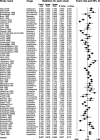How well do elderly patients with major depressive disorder respond to antidepressants: a systematic review and single-group meta-analysis
- PMID: 32131786
- PMCID: PMC7057600
- DOI: 10.1186/s12888-020-02514-2
How well do elderly patients with major depressive disorder respond to antidepressants: a systematic review and single-group meta-analysis
Abstract
Background: Depression is one of the leading causes of the global burden of disease, and it has particularly negative consequences for elderly patients. Antidepressants are the most frequently used treatment. We present the first single-group meta-analysis examining: 1) the response rates of elderly patients to antidepressants, and 2) the determinants of antidepressants response in this population.
Methods: We searched multiple databases for randomized controlled trials on antidepressants in the elderly with major depressive disorder above 65 years (last search: December 2017). Response was defined as 50% improvement on validated rating scales. We extracted response rates from studies and imputed the missing ones with a validated method. Data were pooled in a single-group meta-analysis. Additionally, several potential moderators of response to antidepressants were examined by subgroup and meta-regression analyses.
Results: We included 44 studies with a total of 6373 participants receiving antidepressants. On average, 50.7% of the patients reached a reduction of at least 50% on the Hamilton Depression Scale (HAMD). Subgroup and meta-regression analyses revealed a better response to treatment for patients in antidepressant-controlled trials compared to placebo-controlled trials. Mean age, study duration, percentage of woman, severity of illness at baseline, dose of antidepressants in fluoxetine equivalents, year of publication, setting (in- or out-patients), antidepressant groups (SSRI, TCA, SSNRI, α2-antagonist, SNRI, MAO-inhibitor), ITT (intention-to-treat) analysis vs completer analysis, sponsorship and overall risk of bias were not significant moderators of response.
Conclusions: Our findings suggest an improvement in symptoms can be found in about 50% of the elderly with major depressive disorder treated with antidepressants.
Keywords: Depression; Elderly; Response; Systematic review.
Conflict of interest statement
SL has received honoraria for consulting from LB Pharma International B.V., H. Lundbeck A/S, Otsuka Pharmaceutical Co., Ltd., Teva Pharmaceutical Industries Limited, Chemical Works of Gedeon Richter Plc., Recordati S.p.A., LTS Lohmann Therapie-Systeme AG, Boehringer Ingelheim International GmbH; and for lectures from Janssen Global Services, LLC, Eli Lilly and Company, H. Lundbeck A/S, Otsuka Pharmaceutical Co., Ltd.Sanofi-aventis Groupe and Les Laboratoires Servier. All other authors declare no competing interests.
Figures



References
-
- Murray CJL, Barber RM, Foreman KJ, Ozgoren AA, Abd-Allah F, Abera SF, et al. Global, regional, and national disability-adjusted life years (DALYs) for 306 diseases and injuries and healthy life expectancy (HALE) for 188 countries, 1990–2013: quantifying the epidemiological transition. Lancet. 2015;386(10009):2145–2191. doi: 10.1016/S0140-6736(15)61340-X. - DOI - PMC - PubMed
-
- American Psychiatric Association. Diagnostic and statistical manual of mental disorders: DSM-IV. 4. ed., 3. print. Washington, DC: American Psychiatric Association; 1994.
Publication types
MeSH terms
Substances
Grants and funding
LinkOut - more resources
Full Text Sources
Medical

